Enershare pilot 5 demonstrated how AI, federated learning, and secure data spaces can unlock cross-sector energy flexibility – connecting electricity, mobility, and water systems. By combining digital innovation with social trust, the pilot offers a scalable blueprint for smarter, more resilient energy grids.
1. How Enershare Powers Smart Grids with Cross-Sector Flexibility
Pilot 5 in Italy connects electricity, mobility, and water networks through a federated Data Space to improve grid operations and unlock energy flexibility.
Cross-Sector Flexibility Starts Here
In the Italian city of Terni, an ambitious real-world pilot is transforming how electricity grids interact with surrounding infrastructure. ENERSHARE Pilot 5, led by ASM Terni, shows how cross-sector data integration can unlock new value for Distribution System Operators (DSOs), mobility providers, and water utilities.
By bridging three distinct domains—power networks, electric mobility, and water infrastructure—this pilot creates a data-sharing ecosystem that turns static infrastructure into active grid participants. The backbone of this integration? The Enershare Data Space, a federated and standards-based platform that enables secure, sovereign, and modular data exchange.
What Makes Pilot 5 Unique?
Pilot 5 is structured around three use cases:
- UC5A – Grid Optimization with Federated Learning
- UC5B – EV Charging and P2P Congestion Marketplace
- UC5C – Water Pumps as Flexibility Providers
Infrastructure Snapshot
- PV plants + distributed RES sites
- Power Quality Analyzers and smart meters
- EVs and charging stations with live telemetry
- Building Energy Management System (BEMS)
- Real-time and historical data integration
- Enershare Connectors for interoperability
Why This Pilot Matters?
Pilot 5 delivers tangible benefits:
- AI-enhanced forecasting for grid and pump management
- Real-time EV charging control based on grid needs
- Blockchain smart contracts for DSO-CPO coordination
- Interoperable, plug-and-play data sharing with reusable services
The pilot validates that grid flexibility isn’t only about batteries or demand response—it’s also about better coordination between existing infrastructure sectors.

2, Smarter Grids Through Federated Learning: Optimizing Local Load Forecasting
In ENERSHARE Pilot 5, federated learning helped predict energy demand and reduce grid stress, without compromising data privacy.
Can we predict the energy grid’s behavior without sharing any private data?
In ENERSHARE’s Italian Pilot 5, the answer was yes—thanks to federated learning.
This innovative AI technique allowed the local DSO, ASM Terni, to forecast electricity demand at both household and substation levels, while keeping raw data secure and local. Instead of centralizing sensitive energy data, each site trained its own model, sharing only the knowledge—not the data itself.
The goal? Reduce reverse power flow, improve load balancing, and increase self-consumption—all while respecting GDPR and system constraints. The results were impressive: no transformer overloads were observed, and grid behavior was forecasted more accurately, helping anticipate demand peaks and plan operations more effectively.
Behind the scenes, the service was powered by TNO’s FL framework, integrated via the TSG IDS connector into the Enershare Data Space. Real-time data, predictive models, and secure APIs came together to offer a scalable, privacy-first solution for grid optimization.
As smart grids evolve, so must our tools. Federated learning shows that energy forecasting can be intelligent and ethical—giving DSOs the power to plan ahead, without giving up control.
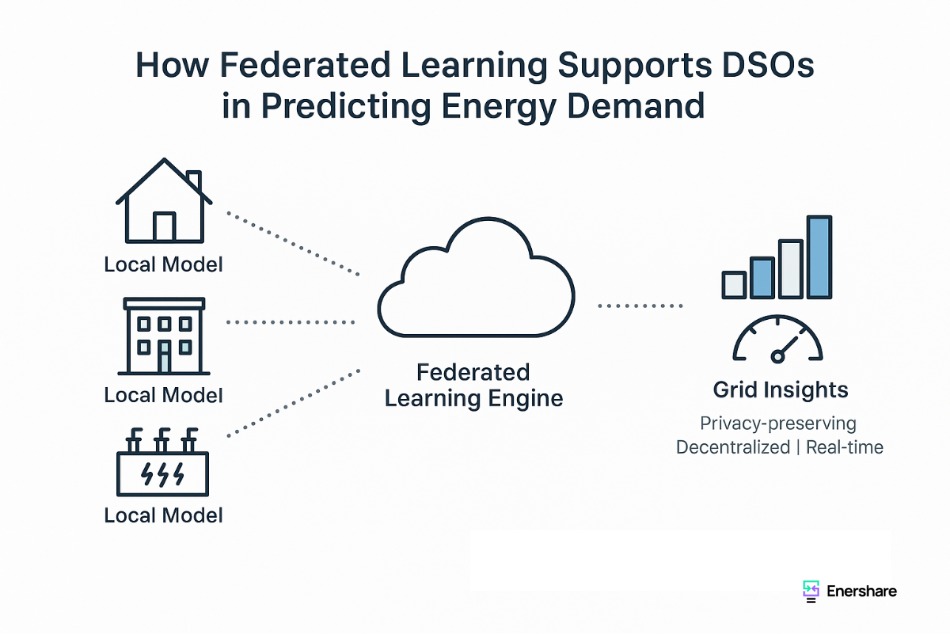
3. AI for Clean Energy: Predicting PV Surplus and Optimizing Self-Consumption
In ENERSHARE Pilot 5, AI models help forecast households and ASM headquarters’ energy use and PV surplus, supporting smarter grid operation and better use of local renewable energy.
As more households install rooftop solar panels and flexible appliances, energy flows in the grid become less predictable and less controllable. For Distribution System Operators (DSOs), one of the biggest challenges is managing the mismatch between local generation and consumption, especially when excess solar energy is fed back into the grid. In ENERSHARE Pilot 5, we addressed this challenge using AI-based forecasting models that predict energy behavior at both the household and grid segment levels.
The forecasting service developed in this pilot focuses on predicting PV surplus, consumption peaks, and overall flexibility potential from residential users. Trained on historical consumption and generation data, the AI models use neural network architectures to anticipate both when households will need energy and when they will produce more than they consume. This allows the DSO to plan operations accordingly, either by absorbing the surplus locally or coordinating with flexibility assets such as EVs and water pumps.
One of the key innovations is the ability to simulate self-consumption scenarios: understanding how much of the PV energy can be used directly at the source, reducing reverse power flow, and enhancing grid efficiency. Forecasting models also estimate reactive power (Q), enabling more accurate voltage management in low-voltage feeders. The models have been validated using data from over 100 users, showing reliable prediction of surplus windows and enabling better flexibility scheduling.
By integrating these forecasts into the ENERSHARE dashboard and grid planning services, DSOs gain actionable insights: when to curtail, when to shift loads, and how to engage consumers in smarter energy behavior. For end users, the benefit is clear—more of their solar energy stays within the community, leading to lower costs and a more resilient grid.
In the context of Use Case 5A, this service complements the federated learning system and enables cross-sector flexibility by predicting when flexibility will be available. The combination of accurate forecasts and decentralized AI tools forms the backbone of smarter, local energy systems that can adapt in real time—without the need for centralized data control.
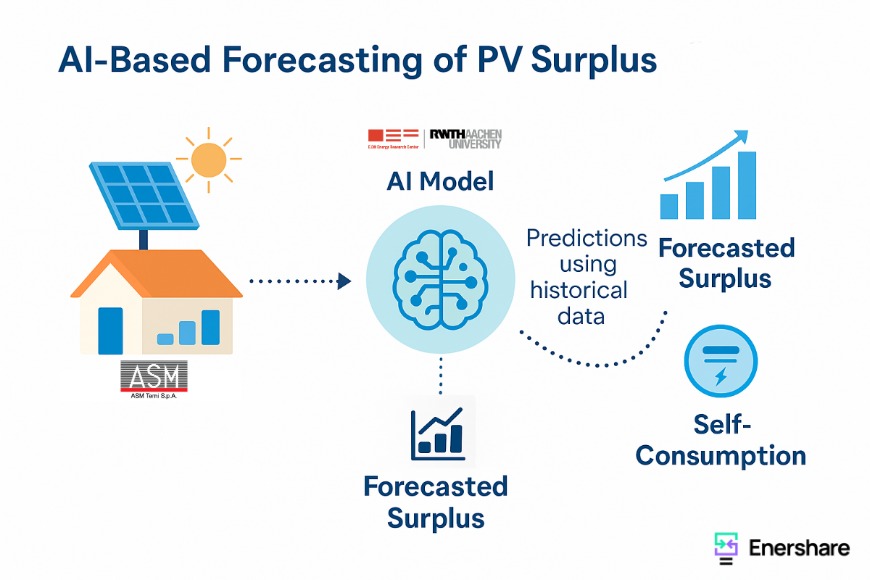
4. Smarter Grid Forecasting: Predicting Tomorrow’s Energy Today
ENERSHARE’s Energy Forecasting Service helps grid operators plan ahead by predicting daily consumption and solar production—turning data into smarter decisions.
As the energy system becomes more dynamic, knowing what tomorrow will bring is essential for smart grid planning. That’s exactly what the Energy Forecasting Service in ENERSHARE Pilot 5 delivers.
Every day, the system gathers sensor data from the previous 24 hours—covering both energy consumption and solar production across households and grid assets. That data feeds into a machine learning model designed to predict how much electricity will be used and generated on the following day. This enables operators to understand when there will be energy surplus, and where flexibility might be needed.
Built on advanced neural networks, the model doesn’t just look at simple averages—it captures the trends, peaks, and seasonal behaviors hidden in the data. It processes hourly values to produce next-day predictions with high granularity.
The real value?
Grid operators and service platforms can:
- Anticipate demand surges or solar peaks
- Identify hours of excess production
- Align charging, pumping, or market activity with predicted surplus
- Improve self-consumption and reduce reverse power flows
The service is deployed in a modular way. Data is securely exchanged between the DSO (ASM Terni) and the forecasting provider (ENG) using the Energy Data Space Connector—a tool purpose-built for the energy sector. Forecasts are delivered via REST APIs, and results are visualized in dashboards, enabling quick insights and scenario simulations.
This service is already deployed and operational—ready to support DSOs, aggregators, or platform providers looking to enhance energy planning with actionable insights.
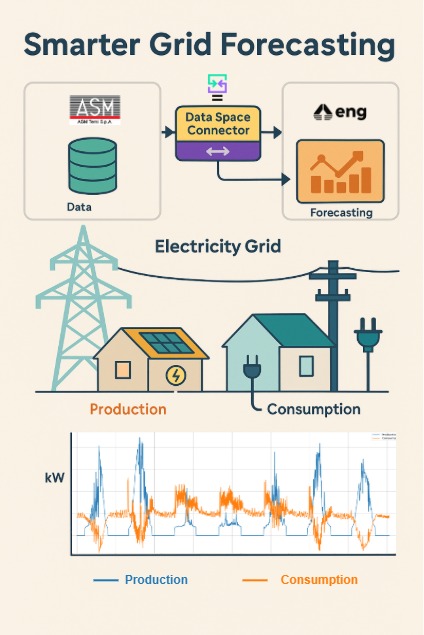
5. Flexible EV Charging in Action: Aligning Mobility with Grid Needs
ENERSHARE Pilot 5 turns EVs into flexibility providers, enabling dynamic charging coordination between operators and DSOs—boosting grid stability and energy efficiency.
Cross-Sector Flexibility Starts Here
As electric vehicles become more common in our cities, so do the opportunities to make their charging smarter—and more sustainable. In ENERSHARE Pilot 5, a pioneering use case shows how EVs can become flexibility assets, offering real benefits to both Charging Point Operators (CPOs) and Distribution System Operators (DSOs).
The flexibility platform deployed in Terni allows CPO (EMOT) to schedule or delay EV charging based on grid needs and market signals. At the core is a data exchange framework using the Energy Data Space Connector, enabling transparent, secure communication between all actors involved.
Here’s how it works:
- The DSO provides forecast data and grid status via the Enershare Data Space
- The CPO (EMOT) adapts EV charging schedules to avoid congestion
- Flexibility availability is sent back to the DSO for validation or market participation
- Smart contracts ensure traceable, rule-based coordination
Charging stations are no longer isolated assets—they’re now part of a broader system. This means fewer overloads, better use of renewable energy, and more cost-effective charging strategies for operators and users.
Real-time data exchange is enabled via APIs, while historical data is shared through the Data Space Connectors. This dual structure ensures scalability and data privacy while still allowing for effective short-term flexibility activation.
What’s the result?
DSOs gain a valuable new tool to manage local grids under stress, while CPOs get a new service to offer—charging optimized for the energy system.
In this pilot, the charging infrastructure is directly integrated into the grid forecasting and marketplace ecosystem, opening the door for dynamic congestion pricing, load balancing, and predictive scheduling based on production forecasts.
This use case represents a key step in making electromobility an active player in energy system flexibility, leveraging shared data, intelligent scheduling, and digital coordination.
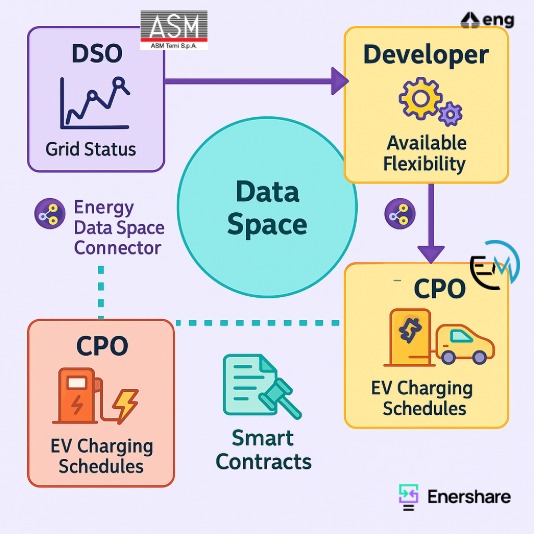
6. Pumps That Think: Flexibility and Forecasting for Smarter Water and Energy Systems
In ENERSHARE Pilot 5, water pumps are evolving into intelligent energy assets—helping the grid stay balanced using AI forecasting, Digital Twins, and secure data sharing.
In ENERSHARE’s Use Case 5, innovation flows through the pipes—literally.
ASM Terni has transformed part of its water infrastructure into a flexible asset for the electricity grid, using a mix of AI forecasting, predictive maintenance, and a Digital Twin of the distribution network.
The idea is simple but powerful:
by forecasting water demand and scheduling pump operations accordingly, ASM can shift electricity usage to hours when solar production is high or grid congestion is low. This benefits both systems—improving energy efficiency while keeping water distribution reliable and cost-effective.
To make this possible, ASM shares pump and system data with its partners via the Energy Data Space Connector. This secure, interoperable layer enables seamless exchange of real-time and historical data. AI models use this data to forecast upcoming energy and water demand, and the resulting predictions are fed directly into a Digital Twin simulation engine developed by RWTH Aachen. The twin replicates real-time grid behavior and tests how different pump schedules impact performance—before any action is taken in the field.
Everything is visualized in an interactive dashboard, helping operators explore scenarios, identify flexibility windows, and monitor pump conditions. The outcome? Reduced power losses, better use of local renewables, and improved coordination between utility sectors.
This use case is a working example of how existing infrastructure—when digitally enhanced—can become part of the flexibility equation. It’s not just the future of water and energy. It’s the future of both, together.
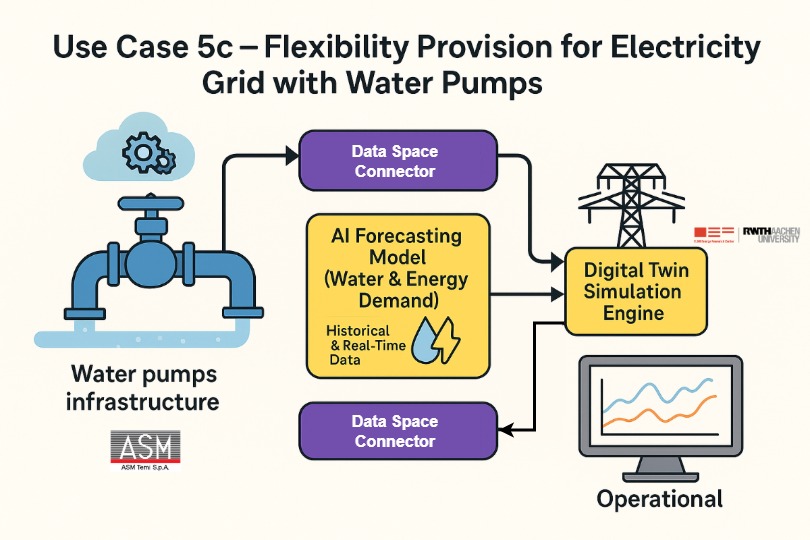
7. Scaling Smart Energy: How to Replicate Pilot 5 Across Regions
ENERSHARE’s Pilot 5 proved that cross-sector energy flexibility works. Here’s how others can follow its lead.
Pilot 5 of the ENERSHARE project brought together energy, mobility, and water to create a flexible, data-driven grid. From coordinating EV charging and water pumps, to using AI forecasts and Digital Twins, the results speak for themselves.
But more importantly—it’s replicable.
The backbone was the ENERSHARE Data Space, enabling secure, interoperable data sharing across partners. It powered AI models, triggered simulations, and returned results without ever exposing sensitive data.
Services were modular, containerized, and API-ready—meaning they can be deployed step-by-step in other regions.
What made it work wasn’t just tech. It was collaboration: DSOs, CPOs, researchers, and data owners worked closely, backed by Italian regulation that encouraged flexibility pilots.
According to Pilot 5, successful replication depends on:
- Access to high-resolution energy data, such as smart meters and Power Quality Analyzers (PQAs)
- Strong local collaboration between DSOs, cities, service providers, and platform developers
- Deployment of a secure and interoperable infrastructure, like the Enershare Energy Data Space Connector
- Alignment with regional policies and market incentives that support flexibility and data sharing
ASM shows that with the right building blocks in place, scaling up smart energy services isn’t just possible — it’s practical.
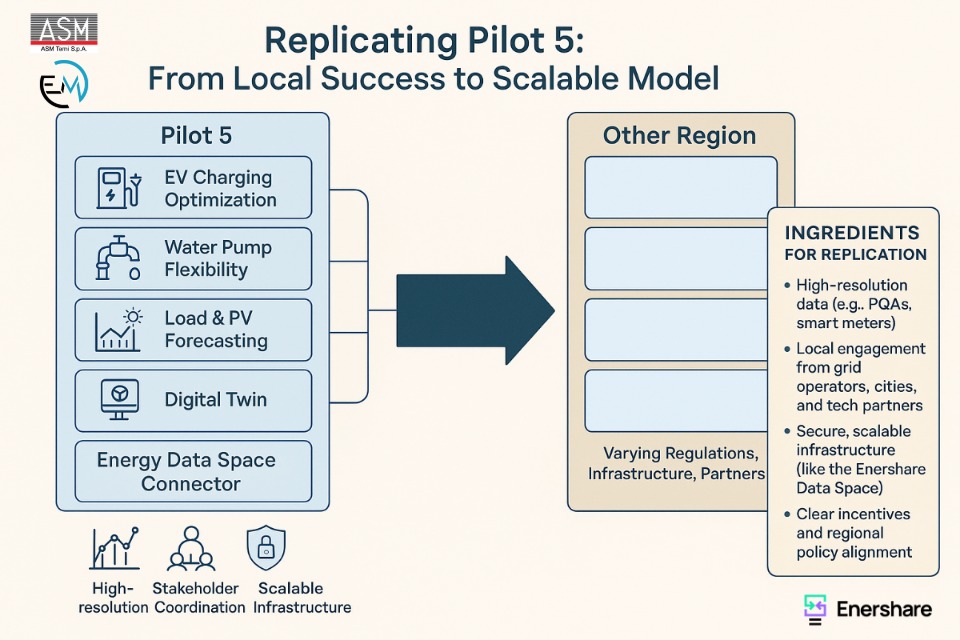
8. Why Data Spaces Matter: Unlocking Secure, Smarter Energy Operations
Pilot 5 showed how data can move across energy actors safely, privately, and with purpose—thanks to the Enershare Data Space.
In ENERSHARE Pilot 5, flexibility services didn’t just depend on smart algorithms—they relied on smart data sharing.
Using the Energy Data Space Connector, partners exchanged production, consumption, and flexibility data securely, without exposing sensitive information or relying on custom integrations.
This infrastructure wasn’t just a backend tool—it enabled forecasting, Digital Twins, and demand-side services to work across platforms and sectors.
The result?
Faster deployments, better coordination, and more trust among operators, developers, and users.
With clear governance, API-driven access, and privacy by design, the Data Space made real collaboration possible.
In a sector where interoperability often feels out of reach, Pilot 5 proved it can be done—and that when it is, everyone benefits.

9. From Pilot to Platform: Trust, Impact, and What Comes Next
Pilot 5 proved that digital energy solutions can work across sectors—but only when people trust them. Here’s what we learned about social acceptance, stakeholder value, and future potential.
As ENERSHARE Pilot 5 comes to a close, the story it tells is more than one of technical success.
Yes, we built forecasting models, activated flexible EV charging, and simulated grid behavior with a Digital Twin. But what truly stood out? People trusted the process. And that trust made all the difference.
Through dashboards, training, and clear data governance, stakeholders—from grid operators to service providers—felt confident participating. Tools like Federated Learning helped protect sensitive data, while still enabling powerful insights. And when users were given access to services they could understand and interact with, they engaged more.
Social acceptance isn’t just a checkbox—it’s a foundation.
In Pilot 5, this meant designing intuitive interfaces, providing transparency about how data is used, and ensuring that services align with real-world needs, like cost savings and better energy control.
Stakeholder value was clear and shared.
From the DSO’s grid stability to the CPO’s charging flexibility, every actor gained. The Data Space wasn’t just a connector—it was the space where collaboration happened. And because of that, service adoption didn’t feel imposed. It felt earned.
Looking ahead, the model is scalable.
Pilot 5 proved that with the right architecture, incentives, and communication, advanced digital energy services can work—and be trusted—across sectors. That’s not just a win for one city. It’s a model for many.

Thank you to everyone who contributed to ENERSHARE Pilot 5.
Let’s keep building a more flexible, connected, and trusted energy system—together.
The pilot validates that grid flexibility isn’t only about batteries or demand response—it’s also about better coordination between existing infrastructure sectors.
